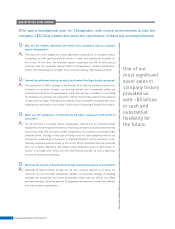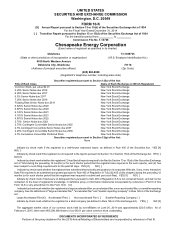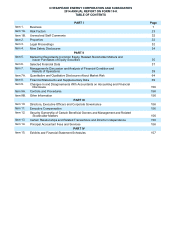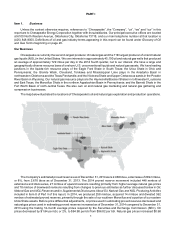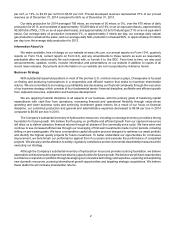Chesapeake Energy 2014 Annual Report Download - page 16
Download and view the complete annual report
Please find page 16 of the 2014 Chesapeake Energy annual report below. You can navigate through the pages in the report by either clicking on the pages listed below, or by using the keyword search tool below to find specific information within the annual report.8
Our proved reserves as of December 31, 2014 included PUDs more than directly offsetting producing wells in
three resource plays: the Haynesville Shale, the Marcellus Shale and the Eagle Ford Shale. In all other areas, we
restricted PUD locations to immediate offsets to producing wells. Within the Haynesville, Marcellus and Eagle Ford
Shale plays, we used both public and proprietary geologic data to establish continuity of the formation and its producing
properties. This included seismic data and interpretations (2-D, 3-D and micro seismic); open hole log information
(collected both vertically and horizontally) and petrophysical analysis of the log data; mud logs; gas sample analysis;
drill cutting samples; measurements of total organic content; thermal maturity; sidewall cores; whole cores; and data
measured in our internal core analysis facility. After the geologic areas were shown to be continuous, statistical analysis
of existing producing wells was conducted to generate an area of reasonable certainty at distances from established
production. Undrilled locations within these proved areas qualify as PUDs; however, due to other factors and SEC
reserves guidance, numerous locations within these three statistically evaluated plays have not yet been booked as
PUDs.
Our annual net decline rate on producing properties is projected to be 30% from 2015 to 2016, 20% from 2016
to 2017, 15% from 2017 to 2018, 13% from 2018 to 2019 and 11% from 2019 to 2020. Of our 1,864 mmboe of proved
developed reserves as of December 31, 2014, approximately 156 mmboe, or 8%, were non-producing.
Chesapeake's ownership interest used in calculating proved reserves and the associated estimated future net
revenue were determined after giving effect to the assumed maximum participation by other parties to our farm-out
and participation agreements. The prices used in calculating the estimated future net revenue attributable to proved
reserves do not reflect market prices for oil and natural gas production sold subsequent to December 31, 2014. The
estimated proved reserves may not be produced and sold at the assumed prices.
The Company's estimated proved reserves and the standardized measure of discounted future net cash flows of
the proved reserves as of December 31, 2014, 2013 and 2012, along with the changes in quantities and standardized
measure of these reserves for each of the three years then ended, are shown in Supplemental Disclosures About Oil,
Natural Gas and NGL Producing Activities included in Item 8 of Part II of this report. No estimates of proved reserves
comparable to those included herein have been included in reports to any federal agency other than the SEC.
There are numerous uncertainties inherent in estimating quantities of proved reserves and in projecting future
rates of production and timing of development expenditures, including many factors beyond our control. The reserve
data represent only estimates. Reserve engineering is a subjective process of estimating underground accumulations
of oil and natural gas that cannot be measured exactly, and the accuracy of any reserve estimate is a function of the
quality of available data and of engineering and geological interpretation and judgment. As a result, estimates made
by different engineers often vary. In addition, results of drilling, testing and production subsequent to the date of an
estimate may justify revision of these estimates, and these revisions may be material. Accordingly, reserve estimates
often differ from the actual quantities of oil, natural gas and NGL that are ultimately recovered. Furthermore, the
estimated future net revenue from proved reserves and the associated present value are based upon certain
assumptions, including prices, future production levels and costs that may not prove correct. Future prices and costs
may be materially higher or lower than the prices and costs as of the date of any estimate.
Reserves Estimation
Chesapeake's Corporate Reserves Department prepared approximately 21% of the proved reserves estimates
(by volume) disclosed in this report. Those estimates were based upon the best available production, engineering and
geologic data.
Chesapeake's Director - Corporate Reserves is the technical person primarily responsible for overseeing the
preparation of the Company's reserve estimates. His qualifications include the following:
• 24 years of practical experience working for major oil companies, including 16 years in reservoir engineering
responsible for estimation and evaluation of reserves;
• Bachelor of Science degree in Petroleum Engineering;
• registered professional engineer in the state of Texas; and
• member in good standing of the Society of Petroleum Engineers.


